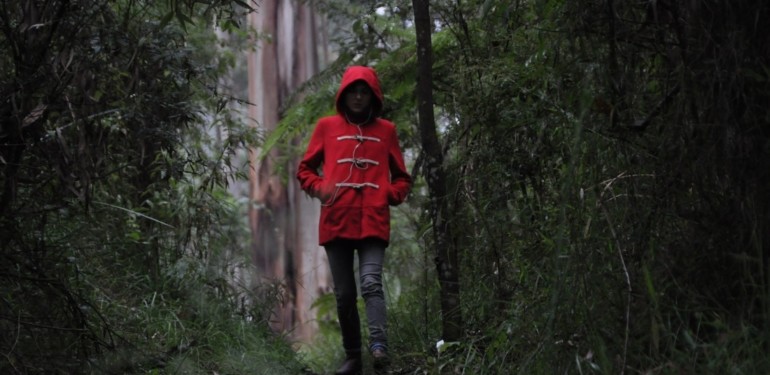Lost Gully Road
In the Q&A following her film, director Donna McRae explained that she shot Lost Gully Road in the Dandenong Ranges. These isolated, lushly green hills that appear frozen in time are a perfect setting for films. McRae utilises the location well, with a ghost story emphasising isolation, with undercurrents of domestic abuse.
Surrounded by towering trees that block out the sun, Lucy (Adele Perovic) is hiding out in a big house. She has no TV, internet and can’t use her phone in case her calls are tracked by an unknown antagonist. Whiling away her time with long walks and failed attempts to chop wood and start a fire, her boredom is interrupted by seemingly paranormal occurrences.
Doors slam on their own, the fire lights itself, and Lucy begins to suspect she’s sharing the house with a malevolent presence. These eerie, early scares which come after long stretches of mundanity are very effective, reflecting the first Paranormal Activity, where a ruffled sheet or a whispered voice was scarier than any of the visual effects-laden sequels.
There’s a real intimacy between the director and actor in the film. It’s a captivating performance from Perovic, whose boredom and frustration are readily apparent, as is her disgust towards the unwanted attention she receives from the local tuck shop owner (played by John Brumpton).
Though its audience is likely to share some of Lucy’s claustrophobic irritation as they wait for something to happen, Lost Gully Road is an effective ghost story which, when it eventually reveals its intentions, tells an important story about consent, using a demonic presence to comment on male entitlement.
Landfall
Travis Bain’s Landfall is another interior chamber piece concerned with unwanted visitors, though instead of subtle scares and mounting dread, this one takes its inspiration from talky action thrillers in the vein of Tarantino’s early work.
During an oppressive cyclone in North Queensland, three fugitives dressed as paramedics force their way into Maisie (Kristen Condon) and Dylan’s (Rob Stanfield) home, just as the couple are about to leave. The men carry an esky containing something valuable and mysterious (there’s that Pulp Fiction influence), one is wounded, and each member may not be who he says he is.
The less said about the plot the better, as this film relies on tripping up the audience’s expectations with continued revelations about exactly who is the perpetrator here and what’s really at stake. As the leader of the fugitives, Paul (Daryl Heath) gives a great monologue on how much he hates that everyone picks The Shawshank Redemption as their favourite film, showing Heath as an excellent scenery-chewer and Bain as a purveyor of entertaining, if slightly indulgent, dialogue. Condon is funny and tragic when she struggles to stay awake after drinking from the same glass of rum she spiked to knock out one of the fugitives, speaking in a drawling mumble and desperately struggling to keep her eyes open.
The film works best when it holds back from the deluge of plot twists, instead reveling in the clever dialogue and the performers’ tension between one another. This is a thrilling and intense ride all the way through, showing Bain as a promising filmmaker.
Tom
Tom Bensley is a freelance writer in Melbourne who reviews anything he attends, watches or reads. It’s a compulsion, really. Follow him @TomAliceBensley.
Monster Fest 2017 ran from November 23 – 26. More reviews and coverage from the festival to come.




